Char siu pork (often simply called Chinese barbecued pork) is a Cantonese classic that is most often seen mixed in with pork fried rice. Sadly, the version of char siu pork in most fried rice is a pale imitation of the real thing. If you’re fortunate enough to have a Chinese barbecue restaurant in your town, you may have seen it—glossy and deep amber red—hanging in the window alongside crisp-skinned roast ducks. Savory and sweet, tender and juicy, char siu pork is usually served with plain white rice, but can also be used in steamed buns or as a tempting addition to soups. But if you don’t have such a restaurant near you, you can enjoy this addictively delicious dish at home by following this recipe from Epicurious and exercising your thermal know-how.
Char siu pork is part of the larger Cantonese category of Siu Mei—fire roasted meats. But what makes it so special, is the sweet, reddish, almost crispy layer of lacquered sauce that is cooked onto it. This lacquer, traditionally made of soy sauce, hoisin, spices, and honey, combined with the traditional wood-fire cooking, imbues the meat with a rose-colored ring near its surface (similar to American barbecue’s famous “smoke ring”). That ring is so characteristic of this dish that many recipes call for red food coloring, a sure way to get red color into the dish, but not strictly traditional.
So we want to make authentic char siu pork with tender and juicy meat inside and a lacquered, sweet crust that’s had some caramelization on the outside. If we watch our temperatures and pick the right meat we can do both.
Caramelization and Maillard
To make great char siu pork, we need caramelization of the sugars, and that only happens with sustained exposure to temperatures above 320°F (160°C). We won’t get that lacquered, sticky exterior at lower temperatures. Temperatures above 300°F (149°C) will also produce Maillard browning from the sugars and the proteins. (Read more about Maillard browning.) The problem with cooking at these higher temperatures is that thin strips of tender cuts like pork loin and tenderloin will easily overcook, becoming tough and dry.
Tender Meat at High Heat
The high-heat problem can be solved, however, by using a tougher cut of meat. Pork shoulder is a great candidate, since it’s usually cooked to 175°F (79°C) anyhow. The high collagen content of the pork shoulder renders to gelatin at those higher temperatures, which makes it tender, not tough. (Usually, this cut is used for long, low cooking, which turns it into fall-apart tender pulled pork, but we don’t need that for char siu pork.) So by using a cut that can stand the heat longer, we end up with char siu pork that is tender (even if not fall-apart tender) and has had the time needed to achieve quality caramelization on the exterior. Cooking at 475°F (246°C) will help the glaze caramelize quickly and will also get the meat into collagen-melting territory quickly. We’ll use a ChefAlarm® to keep track of the temperature, basting our pork once it reaches 145°F (63°C) and then again when it reaches 165°F (74°C), finishing the meat at 170°F (77°C).
On the method:
We went ahead and and cooked the meat over a charcoal fire in a barrel cooker. This gives a more intense flavor and is more authentic. Cooking over a fire is also essential to getting that rosy border, or “smoke ring,” around your meat.
Alternatively, you can cook the meat on a rack in your oven with a ChefAlarm probe, turning it as you baste. But if you have a smoker or grill, we recommend open flame cooking. Part of the special flavor of the authentic dish comes from meat and glaze juices falling into the fire, burning/evaporating, and re-condensing on the surface of the comparatively cooler meat.
Recipe for Chinese Char Siu Pork
From Asian Dumplings by Andrea Nguyen, as seen on Epicurious:
Ingredients
- 2 1/3 pounds boneless pork shoulder, well trimmed (2 pounds after trimming)
- 3 cloves garlic, minced
- 3 tablespoons sugar
- 3/4 teaspoon Chinese five-spice powder
- 4 1/2 tablespoons hoisin sauce
- 3 tablespoons honey
- 2 tablespoons plus 1 teaspoon Shaoxing rice wine or dry sherry
- 3 tablespoons light (regular) soy sauce
- 1 1/2 tablespoons dark (black) soy sauce
- 1 tablespoon sesame oil
Instructions
- Slice pork into strips about six inches long and 1-1 ½ inches thick.

- Make the marinade by combining and whisking together all the other ingredients. Set ⅓ of the marinade aside for basting.

- Marinate the pork, covered, in the refrigerator for 6-8 hours, or overnight, turning the pork 2 or 3 times.

- Remove the pork and marinade from the refrigerator 45 minutes before cooking.
- Heat your grill to 475°F (246°C). We used a Pro-Series® High Temp Air Probe with our ChefAlarm to make sure our cooker was at a high enough temp.
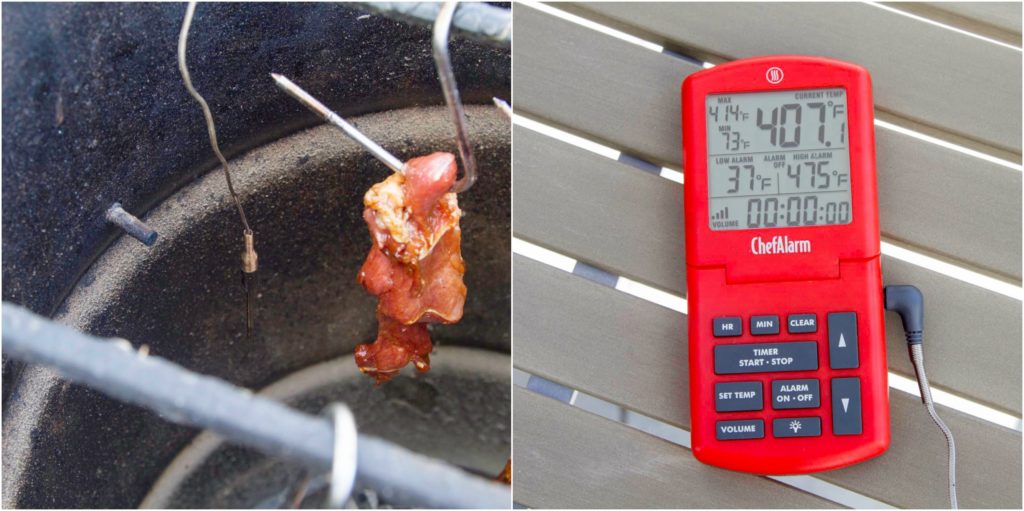
- Hang the pork on hooks in the cooker, spaced so that air can circulate around them. We used a Pit Barrel Cooker.
- Insert a probe attached to a ChefAlarm, and set the high alarm to 145°F (63°C).

- Roast the pork. When the ChefAlarm sounds, spot check the meat with a Thermapen®. Then baste the meat with some of the reserved marinade. Continue to cook the pork, resetting the ChefAlarm high alarm for 165°F (74°C).

- When the ChefAlarm sounds again, baste the meat one more time and reset the ChefAlarm high alarm one more time to 170°F (77°C).

- When the ChefAlarm sounds this last time, verify your final pull temperatures with your Thermapen (we used the new Limited Edition Operation BBQ Relief Thermapen).
- When ready, remove the meat from heat.
- Allow to rest for 10 minutes
- Slice and enjoy!
Cooking at high heat doesn’t lead to tough meat if we use the right cut, and that high heat also yields a tasty glaze that makes this char siu pork (Chinese barbecue pork) as tempting and addictive as any restaurant’s.
Products Used:
Resources: Asian Dumplings by Andrea Nguyen, as seen on Epicurious
The Cooking of China by Emily Hahn (part of the Time-Life Foods of the World series)
Meathead: The Science Of Great Barbecue And Grilling by Meathead Goldwyn
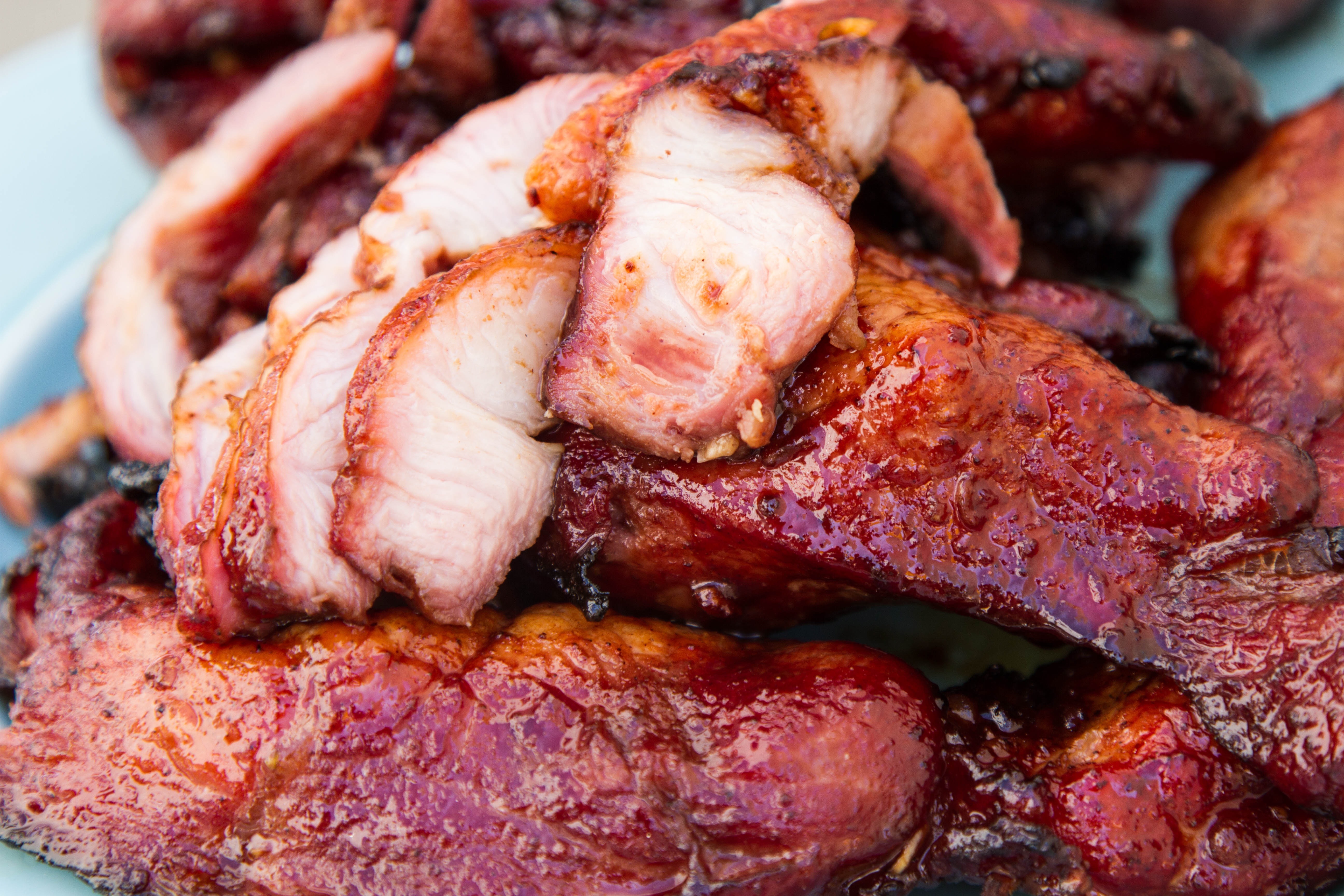
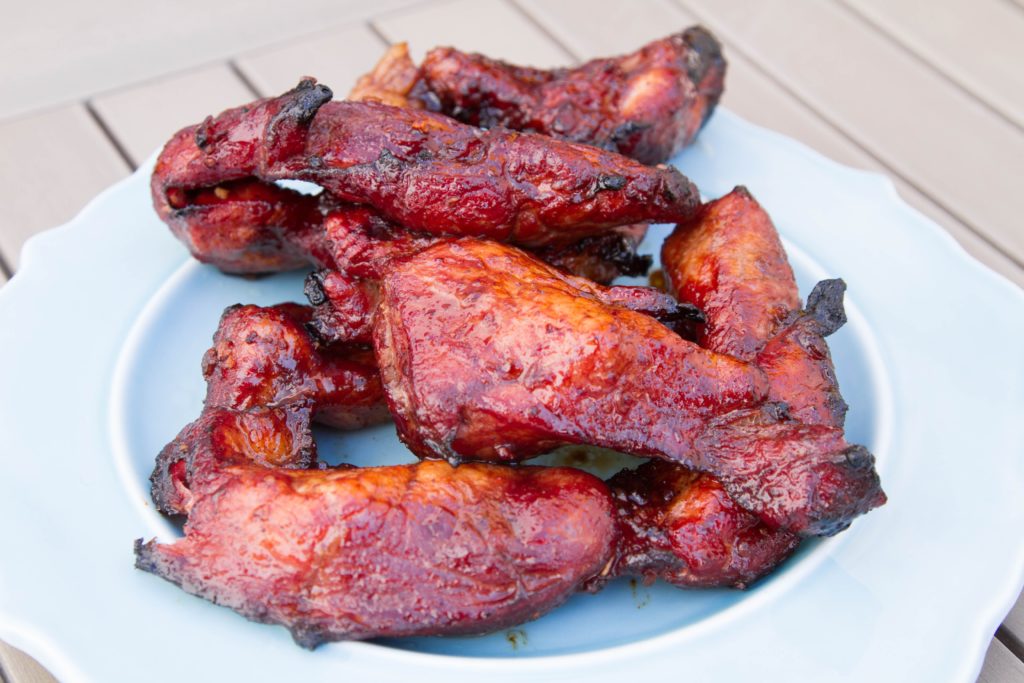
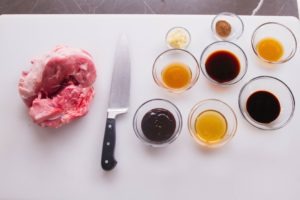
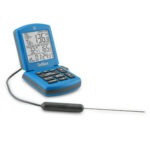
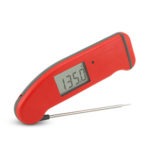
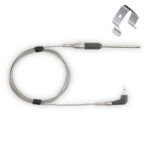

John D Farr says
Nothing as good as a Pit Barrel Cooker!
Michael says
The Pit Barrel cooker is advertised as cooking at a temperature of around 275 with the cover on
I’m assuming therefore that you cooked with the cover off to obtain the 400+ temperature?
Martin says
Michael,
You know your PBC! Yes, we opened the lid a crack to promote greater airflow and higher heat, but we didn’t take the cover off completely. With our air probe, we found that the temp where our meat was hanging was hovering in the region of 475°. Thanks for reading and good luck!
Joshua Segraves says
I want to try this, but I have a WSM… is there any issue with using cooking grates?
Martin says
Joshua,
I’m glad you want to give this recipe a try, as it’s very rewarding. There shouldn’t be any issue with cooking grates rather than hanging hooks. You will just need to turn the meat every 10 minutes or so. You’ll still be getting that authentic fire-flavor, which will be great.
Terry Landon says
Love the recipe. I have a pit barrel cooker. Did you cover during cooking?
Martin says
Terry,
I covered the barrel during cooking but kipped the lid open to the side just a little bit to allow more airflow and a higher heat.
Happy cooking and let us know how it goes!
Rick Krall says
How would you modify for a Weber kettle? I assume you’d suggest indirect cooking, but I’ve not been able to get the indirect side above 460º, and that’s in the beginning with Rockwood lump charcoal. Even if that’s manageable, I doubt I could sustain it for the 2 hrs or so I assume this recipe requires. Of course, if you say “direct cook,” my problem disappears!
Martin says
Rick,
You are correct that indirect heat would be best. If you can’t get all the way up to 475°, go as high as you can. 450° will still get you amazing caramelization and get the meat up into the collagen breakdown zone without too much trouble. As for the time, you don’t need anything near 2 hours. The original recipe calls for ~35 minutes, and we found that we reached our desired temperatures in about that much time, maybe a little less.
Direct heat will probably not give you as much caramelization as charring with this sugary a glaze.
So, give indirect heat a try. Just keep an eye on the internal temp of your pork and it should turn out fine.
sandy says
How would this be done on a Weber kettle grill?
Martin says
Sandy,
This is a good question. No, a barrel cooker is not the only way to do this recipe. You could do this on a Weber kettle that has been set up for indirect heat, and by doing so you will still get the smoke ring and that wonderful fire-cooked flavor.
Give it a try and let us know how it goes!
John Lee says
Use malt sugar instead of honey.
If you want simple way for the source, just get Char Siu Source (in a jar)at Chinese Grocery Store.
Martin says
John,
First, thanks for reading! Yes, the use of malt sugar is a great way to do this recipe. The malt sugar will give it the same sticky shine that we want, and it often is used in traditional recipes for char siu. However, it is not readily available in most grocery stores.
As for the jarred char siu sauce, quality varies from brand to brand and maker to maker. By making your own sauce, you control the flavor and quality, adjusting for personal taste. But you are correct! A jarred sauce is a great way to jump into this for those that don’t want to (or have the time to) make the marinade themselves.
Susan Frentzel says
How about gas grills and Trager smokers.
I used to love char sui in Hawaii but haven’t found it anywhere else..I thought I could smell it in Hong Kong but nobody could find what I wanted.
I would love to trying to make it if a gas grill or smoker will work!????????
Martin says
Susan,
Aloha! A gas grill should be just fine, especially if you can just turn on just one side. High but indirect heat is what you’re after to get the caramelization. Your Traeger smoker turned to High will get to 400°-450° which is hot enough.
As for the flavor with a gas grill…Well that’s a little more complicated. If you set it up for indirect cooking, you’re missing out on the juices dripping down onto the flame, burning/boiling off and sticking to the food. To get that flavor, you might try turning one side of the grill to high and turn the cooking side to low. Then any drips should still burn off, albeit more slowly, and give you that fire-cooked taste. Good luck!